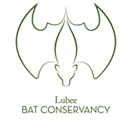
Get Involved
Plant a Bat Garden
From Organization for Bat Conservation
CLICK HERE for a pdf file
Bats eat night flying insects. If you would like to attract bats to your garden, you may want to plant flowers that are late day blooming or night-scented. These plants will attract night pollinators, like moths, which bats like to eat.
BUILD and/or INSTALL a BAT HOUSE
Backyard Habitat for Wildlife
From the US Fish and Wildlife Service
http://www.fws.gov/...BatBoxPlanForIN.pdf
Here are directions for building and installing a bat house.
The Bat House Builder's Handbook
From Bat Conservation International
http://batcon.org/pdfs/BHBuildersHdbk13_Online.pdf
Building and installing a bat house can make a
difference for bats and help promote a healthy environment.
Habitat for Bats
http://www.habitatforbats.org/
Check out this web site for information about bats, chosing a bat house, putting up bat houses and more.
CITIZEN SCIENCE
Alaska Bat Monitoring Project
http://aknhp.uaa.alaska.edu/akbats/index.htm
The Alaska Bat Monitoring Program is a volunteer-based effort designed to assess the current status of bats in Alaska. The goal is to learn where bats are found in the state and to assess their baseline populations. We are also interested in habitat variables associated with their presence. Because our knowledge of bats is very limited in Alaska, we are looking for observations to be reported from any area where bats are observed in our state.
Go Batty this Summer!
From New Hampshire Fish and Game
http://www.wildlife.state.nh.us/surveys/bats.html
Be the most creative host in your neighborhood – host a bat count this summer! New Hampshire’s two most common bat species, the little brown bat and the big brown bat, use buildings as their summer roosts. Abandoned houses, barns, church steeples – and even currently-occupied structures – can provide a summer home to female bats and their young. Monitoring these “maternity colonies” can give biologists a good idea of how bat populations in an area are doing from year to year. With the occurrence of White Nose Syndrome in New Hampshire, monitoring these colonies is more important than ever. People in states all across eastern US are counting bats this summer. Won’t you join them?
Wisconsin Bat Program
http://wiatri.net/inventory/bats/
In general, bats are difficult to study because they are nocturnal, fast fliers, roost in inconspicuous places and can move great distances in short periods of time. As such, lack of information on basic biology and ecology is one of the greatest limitations to conservation of bat species. The Wisconsin DNR Bat Program (WBP) has turned to the WI Citizen-Based Monitoring Network for assistance with monitoring bats in the state. Using trained volunteers has allowed the WBP to gather large amounts of data from across Wisconsin. You can volunteer to monitoring bats in the state! Monitors conducting acoustic and roost surveys across the state for the past seven years have helped the WBP determine species distribution and relative abundance in Wisconsin.






















